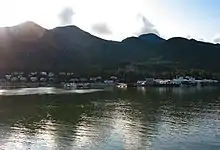Klemtu
Klemtu is an unincorporated community on Swindle Island in the coastal fjords of British Columbia, Canada. It is located on Kitasoo Indian Reserve No. 1.[1]


Klemtu is the home of the Kitasoo tribe of Tsimshians, originally from Kitasu Bay, and the Xai'xais of Kynoch Inlet,[2] extends eastward from Queen Charlotte Sound, approximately at 52.767462°N 128.10688°W. It is adjacent to the Fiordland Conservancy. These two tribes live together as, and are jointly governed by, the Kitasoo/Xai'xais Nation. Traditional languages spoken at Klemtu are the southern dialect of the Tsimshian language, called Southern Tsimshian, and Xaixais, a dialect of the Heiltsuk language. In religious affiliation, the community is dominated by the United Church of Canada.
The government of the Kitasoo/Xai'xais Nation is a member government of the Oweekeno-Kitasoo-Nuxalk Tribal Council.
The population of Klemtu in 1983 was 269. As of 2007 the population of Klemtu was 505.
Name origin
An alternate older name for Klemtu is Kitasoo.[3] it was also known as China Hat due to the shape of Cone Island, which protects it from the open water. The name Klemtu is from the Coast Tsimshian language "Klemdoo-oolk," meaning "impassable".[4]
Folklore
Around 1968 Sasquatch were reportedly seen by people from the village of Klemtu. Bigfoot researcher John Green and Bob Titmus visited Klemtu to investigate the sightings. Their findings indicated that the villagers rarely traveled inland. In older times there was only one trail on the island, across one end of it. The people went everywhere by boat, even hunting and trapping on the beaches, and told stories of apes in the islands. A Klemtu villager named Joe Hopkins reported seeing a Sasquatch on a clam beach. Others encountered Bigfoot when they hunted or fished. A crew of men from Klemtu who were building a dam on a lake above the village had seen tracks on a beach. The varying size of tracks indicated to John Green that a family of Sasquatch were present. This is the first report of a family of Sasquatch. The natives reported stories of the apes swimming from island to island. Sasquatch prints were also reported found in snow on the boardwalks of the unused bunkhouses behind Klemtu Cannery.[5]
In late 2014 Survivorman Les Stroud did a special on Klemtu where he investigated Bigfoot. The special aired in April, 2015.
References
- "Klemtu". BC Geographical Names.
- Kynoch Inlet
- "Kitasoo". BC Geographical Names.
- "Klemtu". BC Geographical Names.
- Green John (1968), On the Track of the Sasquatch. Cheam Publishing Ltd.
External links
Bibliography
- Inglis, Gordon B., et al. (1990) "Tsimshians of British Columbia since 1900." In Handbook of North American Indians, Volume 7: Northwest Coast, pp. 285–293. Washington: Smithsonian Institution.
- Miller, Jay (1981) "Moieties and Cultural Amnesia: Manipulation of Knowledge in a Pacific Northwest Coast Native Community," Arctic Anthropology, vol. 18, no. 1, pp. 23–32.
- Miller, Jay (1982) "Tsimshian Moieties and Other Clarifications," Northwest Anthropological Research Notes, vol. 16, no. 2, pp. 148–164.
